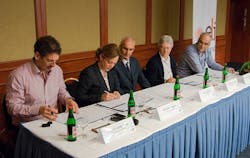Secondary sources beamlines contracts signed for ELI-ALPS facility
A project kick-off ceremony was held on April 17, 2015 in Budapest on the occasion of the contract made between the University of Lund (Sweden), the Institute of Photonics and Nanotechnology of the National Research Council (IFN-CNR; Italy), the Foundation for Research and Technology, Hellas (FORTH; Greece), and the Extreme Light Infrastructure Attosecond Light Pulse Source (ELI-ALPS) laser research center being built in Szeged, Hungary.
RELATED ARTICLE: Extreme Light Infrastructure officially becomes an international organization
At the event, Viktória Tölgyesi, coordination director of ELI-HU Non-Profit Ltd., professor Károly Osvay, research technology director of ELI-HU Non-Profit Ltd. and representatives of the above mentioned partners opened the project of ELI-ALPS's four secondary sources and signed the project opening documents. According to the contracts, the winners of the open public procurements will be responsible for the implementation of four secondary sources beamlines from April 2016 to the end of 2017. The contracts worth 350,000 euros each or 1.4 million euros combined.
Professor Károly Osvay, research technology director of ELI-HU Non-profit Ltd. described the scientific importance of the agreement: "The projects launched today involve our partners in engineering the secondary sources beamlines driven by high repetition and single-cycle, so-called SYLOS laser systems. The building and deploying will be carried out in close cooperation with our partners after the arrival of the lasers from the Spring of 2016. For the perfect operation of these devices, we will have to procure further hardware infrastructure for approximately 6 million euros."
Giuseppe Sansone, Secondary Sources Infrastructure Division leader for ELI-HU Non-profit Ltd. said, "Two out of the four beamlines contracted today will be pronouncedly developed for freelance users. My colleagues and I will be constantly improving the other two beamlines, and implement these changes on the two user-beamlines. This way we can provide the opportunity for freelance users to work uninterruptedly, and in the meantime, the beamline developments will be continuous."
Viktória Tölgyesi, coordination director of ELI-HU Non-Profit Ltd. said on the ceremony: "It is my pleasure to announce that according to these contracts, the planning of the attosecond sources for the laser systems that have already been procured and are under construction, can now begin. These beamlines will provide a perfect opportunity for our colleagues and freelance users as well to achieve their scientific objectives."
Luca Poletto of IFN-CNR added, "The Institute of Photonics and Nanotechnologies (IFN) of the National Research Council of Italy is very proud to be involved in the ELI Attosecond project, as a top scientific initiative pushing the limit of a new class of laser facilities. We hope that the almost twenty-year experience gained by IFN in generation, managing and use of ultrashort coherent light pulses will be precious for the development of this exciting project."
Kalpouzos Constantinos of FORTH also said, "In the last 15 years the attosecond S&T laboratory of FORTH is one of the few laboratories that systematically develops novel methods and devices dedicated to the generation and use of energetic attosecond pulses. ELI-ALPS, thanks to the beyond the state of the art laser sources that will operate, is the infrastructure that has the potential to offer attosecond pulses with the best worldwide specifications regarding pulse energy, repetition rate and duration. FORTH is thus highly interested to contribute with its expertise to this European endeavor in the framework of an R&D project during which FORTH in collaboration with ELI-ALPS will develop and construct one of the attosecond users' beam-line of the infrastructure."
SOURCE: ELI-ALPS; http://eli-alps.hu

Gail Overton | Senior Editor (2004-2020)
Gail has more than 30 years of engineering, marketing, product management, and editorial experience in the photonics and optical communications industry. Before joining the staff at Laser Focus World in 2004, she held many product management and product marketing roles in the fiber-optics industry, most notably at Hughes (El Segundo, CA), GTE Labs (Waltham, MA), Corning (Corning, NY), Photon Kinetics (Beaverton, OR), and Newport Corporation (Irvine, CA). During her marketing career, Gail published articles in WDM Solutions and Sensors magazine and traveled internationally to conduct product and sales training. Gail received her BS degree in physics, with an emphasis in optics, from San Diego State University in San Diego, CA in May 1986.
